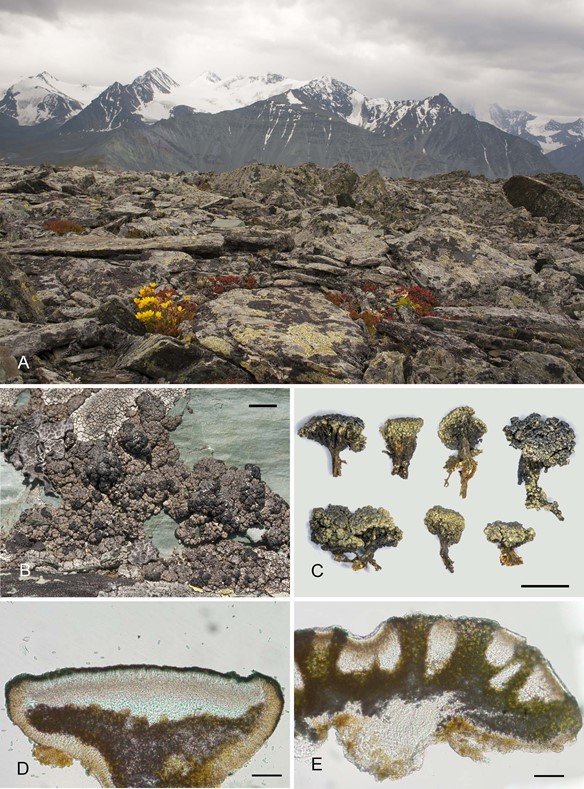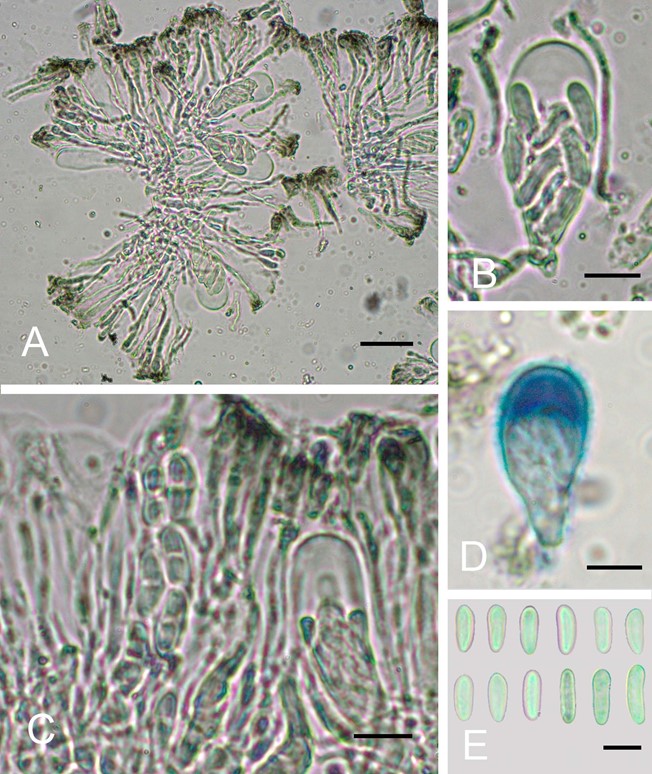Pulvinora stereothallina Davydov & Yakovczenko, sp. nov. Figs. 2B–E & 3A–E
MycoBank number: MB 838037; ndex Fungorum number: IF 838037; Facesoffungi number: FoF;
GenBank Accession nos.: MW257118 (ITSþnuLSU), MW257159 (mtSSU)
Similar to Pulvinora pringlei but differs by its longer ascospores (10.0–15.0 vs. 7.5–10.0 lm), its inconspicuous pycnidia, its lack of maculae, and by producing atranorin and the stictic acid complex instead of psoromic and/or alectorialic or norstictic acids.
TYPE: RUSSIA. REPUBLIC OF TUVA: Mongun-Taiginsky District, Mongun-taiga massif, headwaters of the Mugur River at 27.5 km W from Mugur- Aksy, 50º18’22″N, 90º04’26″E, elev. 3000–3100 m, alpine meadows and mountain tundra with stones, on siliceous rocks, 13 July 2014, E.A. Davydov 14817 & L.S. Yakovchenko (holotype, LE-L-15134!; isotype, ALTB!).
Description. Thallus bullate-squamulose to distinctly stalked, crustose-fruticose, pulvinate, i.e., forming dense cushions of closely aggregated bullate-squamulose areoles, anchored to their substrate by long, terete stalks that resemble the pseudopodetia of Stereocaulon, individual squamules/areoles ± circular in outline, apically 0.4–3.0 mm wide, narrowing below into a ramified stalk, each squamule/areole attached to one stalk branching from a common trunk, lead-grey, brownish- grey, violet-brown-grey, cushions thick and up to 10 cm in diam., loosely attached to the substrate, without vegetative propagules or prothallus, resembling Stereocaulon species; squamules (0.40–)0.55– 1.10–1.70(–3.00) mm wide (N=39), first convex then plane and concave, with crenulate and somewhat swollen margin, coalescent into clusters up to 12 mm wide; surface beige, light brownish, middle brown, matt to shiny, foveolate with white to grayish pruina on the margins and on raised parts of the squamules. Thallus up to 1.5 cm thick; cortex 95.0–141.0–187.5(–237.5) lm tall (N=42), proso-plectenchymatous, of dense, irregularly oriented hyphae, colorless, in upper part covered by brown- ish crystals and in parts by an epinecral layer 12.5– 57.5 lm tall (N=9); algal layer (50.0–)84.0–121.5– 159.0(–225.0) lm tall (N=15), initially continuous and horizontal, later forming vertical columns extending to the upper surface; photobiont green trebouxioid algae, up to 17.5 lm in diam.; medulla of thick hyphae, non-translucent, grey, with poorly- distinguishable structure. Apothecia (0.50–)0.9–1.4– 1.8(–3.3) mm in diam. (N=45), numerous, coalescing into clusters up to 7 mm wide, resembling those of Miriquidica species, protruding above the thallus surface, stipitate, at the tip of root-like branched brownish stalks, rarely single, broadly attached or immersed in the cushions, initially plane with thin black margin up to 0.1 mm wide, soon strongly convex to spherical with disappearing margin, mycolecanorine (with photobionts below hypothecium but not in thalline exciple); disc black (not changing color when wet), rounded, irregular to crenulate, cracked, uneven, shiny, rarely dull, without pruina. Hymenium colorless (30.0–)35.5– 38.0–40.0(–45.0) lm tall (N=21); epihymenium emerald green to green, K–; subhymenium and hypothecium (50.0–)65.0–82.0–99.0(–150.0) lm tall (N=16), consisting of a pale ochre-yellow to colorless subhymenium (25.0–)26.5–38.5–51.0(– 67.5) lm tall (N=23) and hypothecium above the photobiont layer, composed of thick-walled hyphae with narrow, elongate and net-like, branched lumina; algal layer continuous to discrete, of green algae up to 15.0 lm in diam.; medulla of thick hyphae up to 7.5 lm wide, with narrow elongated lumina, non-translucent, grey, with crystals; thalline exciple (amphithecium) persistent, devoid of algae, (22.5–)28.5–36.0–43.5(–57.5) lm wide (N=24), of radial, thick-walled hyphae with narrowly elongate lumina and brownish terminal cells, I–, opaque with brownish crystals dissolving in K, basally merging with the cortex; proper exciple (parathecium) indistinct, colorless, ochre-yellow to brownish; paraphyses branched and anastomosed, (1.6–)1.7– 2.0–2.4(–2.5) lm (N=14) wide in midhymenium with cylindrical to narrowly clavate tips (3.2–)3.6– 4.2–4.7(–5.6) lm wide (N=11) with pigmented caps; asci clavate (27.5–)31.0–34.2–37.2(–40.0) 3 (12.5–)12.5–13.5–15.0(–17.5) lm (N=12), 8-spored, Leca–nora-type; ascospores (10.0–)12.0–12.5–13.0(–15.0) 3 (3.5–)4.0–4.5–5.0(–5.0) lm (N=48), simple or rarely with one thin septum, colorless, narrowly ellipsoid, sometimes with one attenuated tip.
Chemistry. Thallus cortex K+ yellow, C–, KC–, P–, UV–; medulla K–, C–, KC–, P–, UV–; TLC: stictic acid complex and atranorin.
Etymology. The name refers to the characteristic three-dimensional thallus structure.
Substratum and ecology. This species grows on hard volcanic rocks, on outcrops at the local summits, in well insulated conditions, often in cracks of the rocks, in the alpine belt, at 2450– 3100 m above sea level.
Distribution. Pulvinora stereothallina is so far known only from the Altai Mountains (Russia and Kazakhstan) where it was collected in the Katunsky Range, Yuzhnyi Altai Range, Ukok Tableland, and the Mongun-Taiga Massif. The most distant local- ities are ca. 300 km apart.
Additional specimens examined. RUSSIA. RE- PUBLIC OF ALTAI: Ust’-Koksinsky District, Katunsky range, watershed between the Ak-Kem and Kucherla Rivers, 50°00’01.1″N, 86°28’32.9″E, elev. 2764 m, 16 August 2009, E.A. Davydov 14820 (ALTB); 50°02’37.1″N, 86°27’34.9″E, elev. 2720 m, 18 August 2009, E.A. Davydov 16530 (ALTB); Kosh-Agachsky District, Sailjugem Range, left bank of the Bayan- Chagan River at 6.5 km upstream of the junction of the Karasu River, 49°30’19″N, 88°46’38″E, elev. 2800–3000 m, on siliceous rock, 13 June 2014, E.A. Davydov 21001 & L.S. Yakovchenko (HB. DAVYDOV & YAKOVCHENKO); same Range, watershed of Bayan- Chagan and Sarzhemoty Rivers at 4 km to S from its junction, 49°32’00″N, 88°45’01″E, elev. 2750 m, on siliceous rock, 14 June 2014, E.A. Davydov 18235 & L.S. Yakovchenko (HB. DAVYDOV & YAKOVCHENKO). REPUBLIC OF TUVA: Mongun-Taiginsky District, Mon- gun-Taiga Massif, headwaters of the Mugur River at 27.5 km W from Mugur-Aksy, 50°18’35″N, 90°04’06″E, elev. 2800 m, 13 July 2014, E.A. Davydov 14819 & L.S. Yakovchenko (ALTB); left side of the Toolaity River’s valley at 3.5 km upstream from the Eski-Toolaity Lake, 50°11’N, 90°09’E, elev. 2450–2600 m, 4 July 2014, E.A. Davydov 14821 & L.S. Yakovchenko (ALTB); 50°10’19″N, 90°09’21’E, elev. 2700–2800 m, 5 July 2014, E.A. Davydov 14822 & L.S. Yakovchenko (ALTB); KAZAKHSTAN. VOS- TOCHNO-KAZAKHSTANSKAIA OBLAST’: Katon-Karagaisky District, Yuzhnyi Altai Range, headwaters of the Kara-Kaba River, 49°03’50.5″N, 86°21’54.7″E, elev. 2735 m, 10 September 2011, E A. Davydov 16531 (ALTB); 17.5 km S from Uryl’ settlement, at the headwaters of the left junction of the Kara-Kaba River, 49°04’25.0″N, 86°20’55.2″E, elev. 2517 m, on rocks, 4 September 2013, E.A. Davydov 14823 (ALTB); Ukok Tableland, headwaters of the Bukhtarma River, right bank, SE slope of the Muzdy-Bulak Mt. (3050 m), 49°13’53″N, 87°14’10″E, elev. 2680 m, 31 August 2012, E.A. Davydov 14818 (ALTB), E.A. Davydov 16688 (ALTB).

Figure 2. A–E. Pulvinora stereothallina. A. Typical habitat on Sailjugem Range, right bank of the Bayan-Chagan River. B. Thallus with apothecia, field photo. C. Squamules with pseudopodetia-like stalks. D. Section of mycolecanorine apothecium showing the photobiont layer. E. Section of thallus with vertical columns of photobionts extending to the upper surface. Scales: B=5 mm; C¼0.5 mm; D&E=100 lm.

Figure 3. A–E. Pulvinora stereothallina. A. Squashed section with asci and paraphyses. B. Ascus with 8 spores. C. Ascus with atypical 1-septate spores. D. Lecanora-type ascus stained in Lugol’s iodine. E. Ascospores. Scales: A=20lm; B–E=10 lm.
